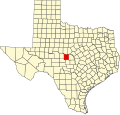McCulloch County Courthouse | |
 McCulloch County Courthouse in 2010 | |
| Location | Public Square Brady, Texas |
|---|---|
| Coordinates | 31°9′6″N99°20′5″W / 31.15167°N 99.33472°W |
| Area | 2 acres (0.81 ha) |
| Built | 1899 |
| Architect | Martin & Moodie |
| Architectural style | Richardsonian Romanesque |
| NRHP reference No. | 77001515 [1] |
| TSAL No. | 469 |
| RTHL No. | 3286 |
| Significant dates | |
| Added to NRHP | December 16, 1977 |
| Designated TSAL | May 28, 1981 |
| Designated RTHL | 1967 |
The McCulloch County Courthouse is located in Brady, McCulloch County, in the U.S. state of Texas. It was added to the National Register of Historic Places listings in McCulloch County, Texas in 1977, and became a Recorded Texas Historic Landmark in 1967. [2]




